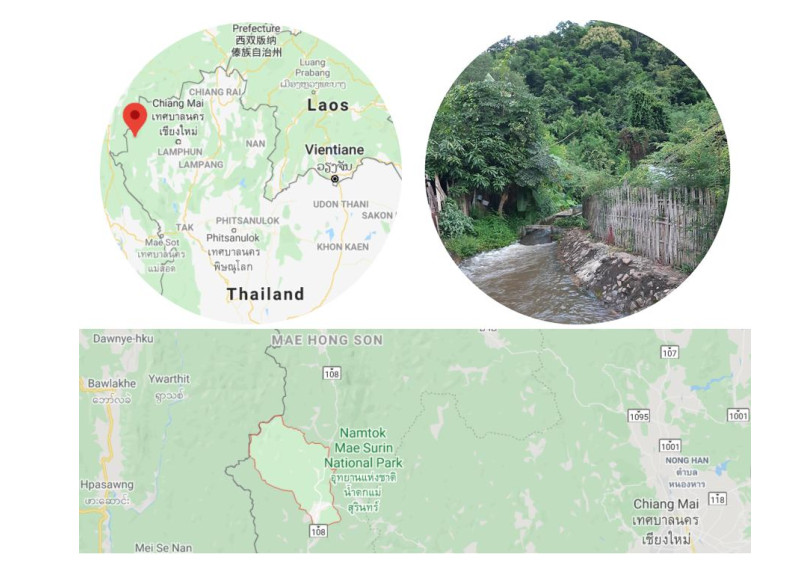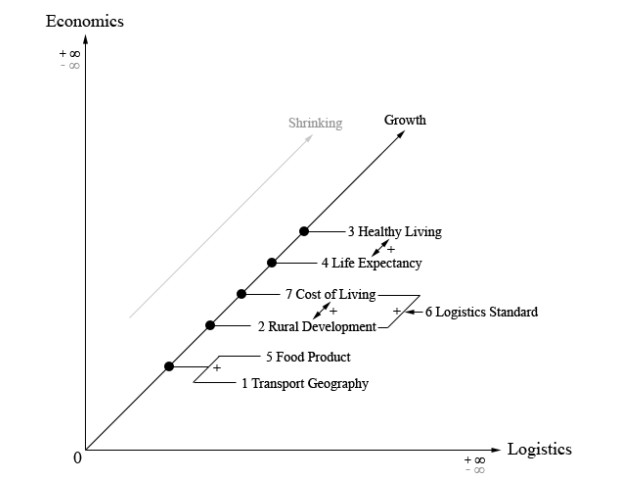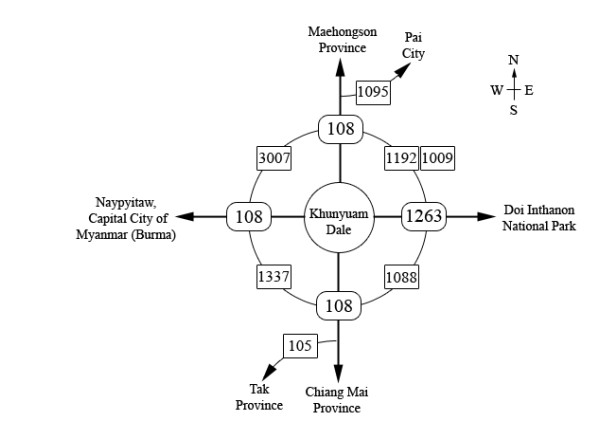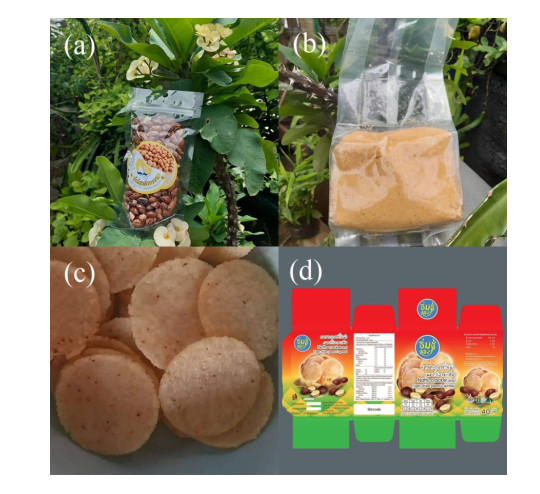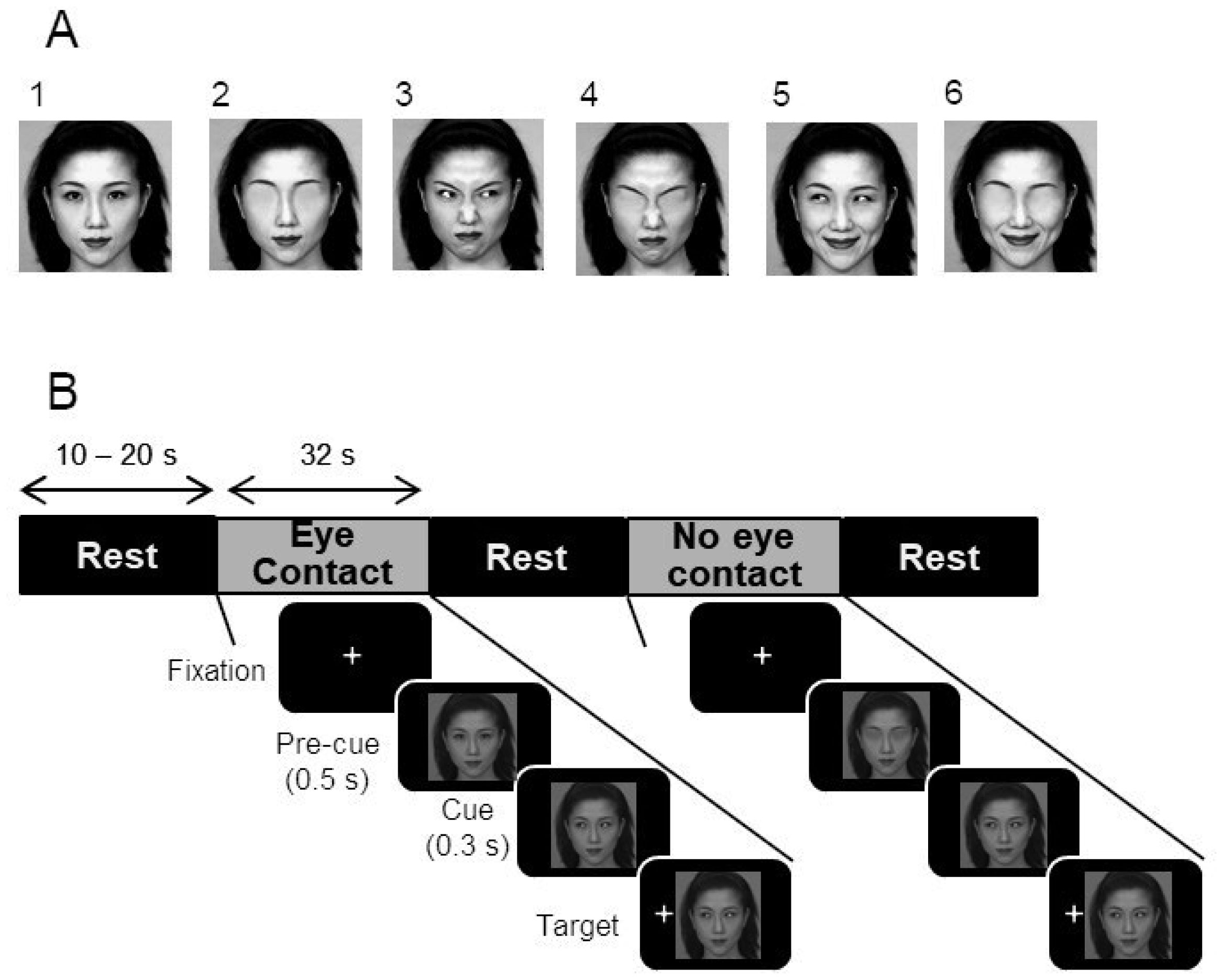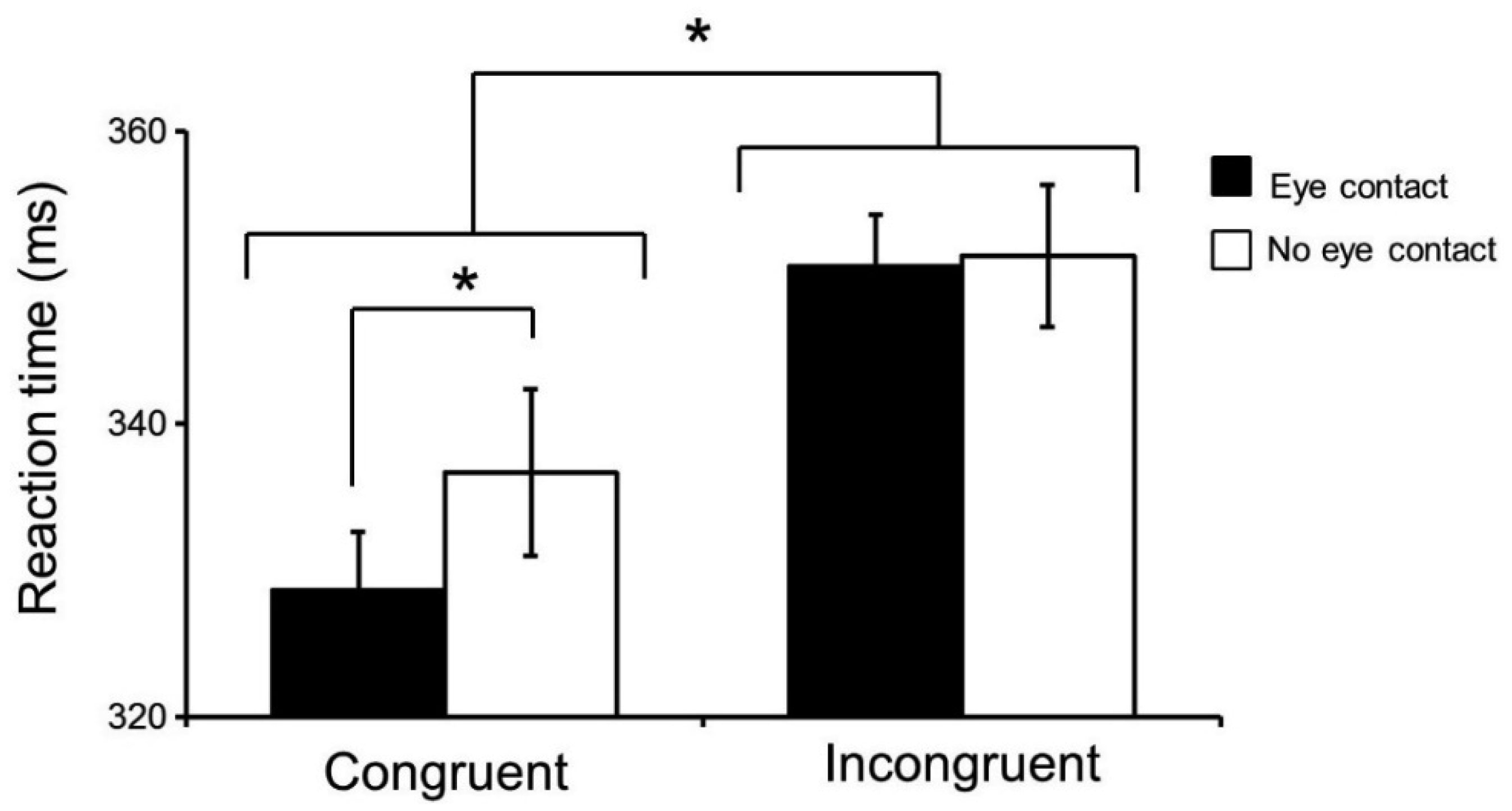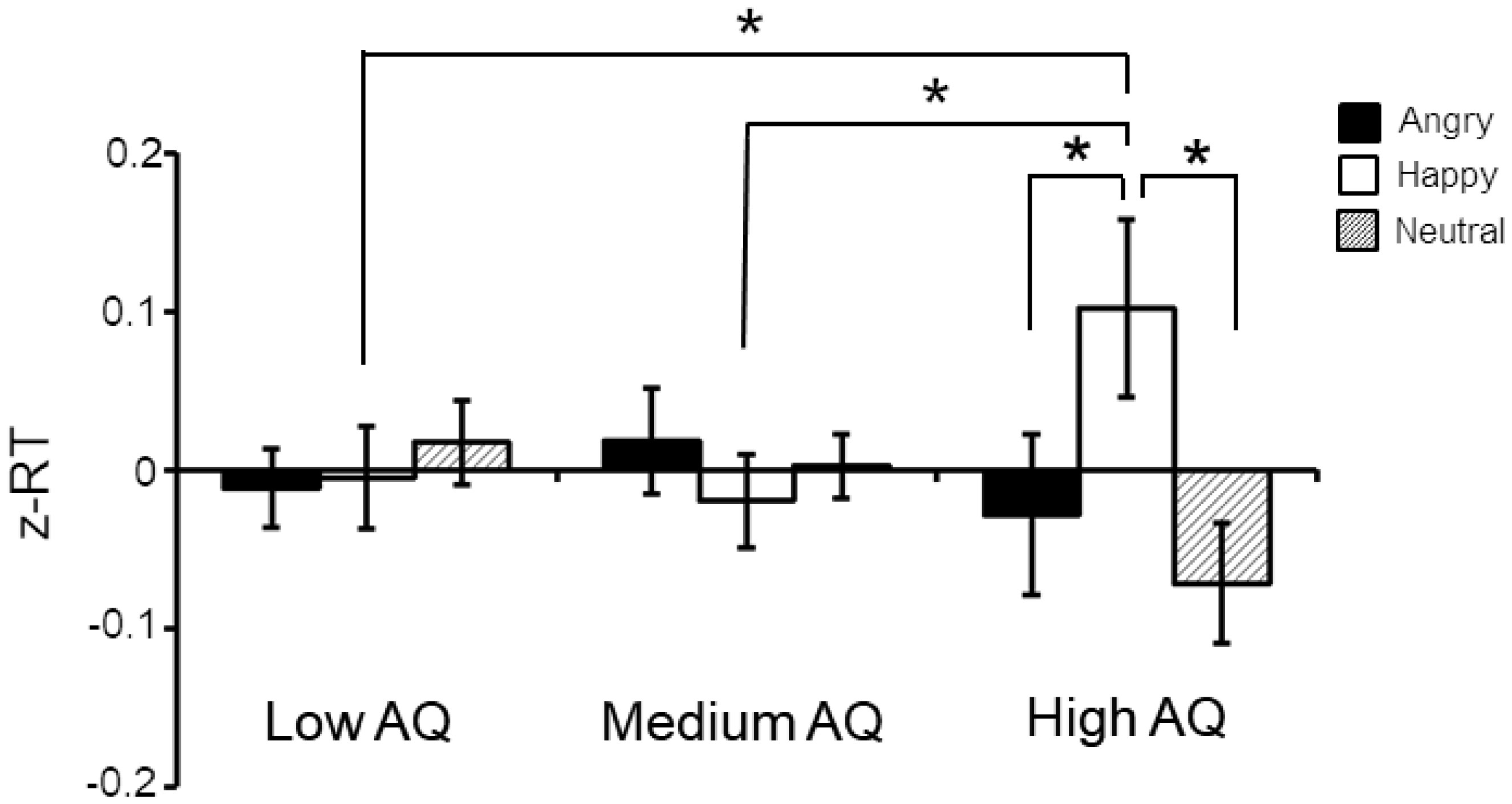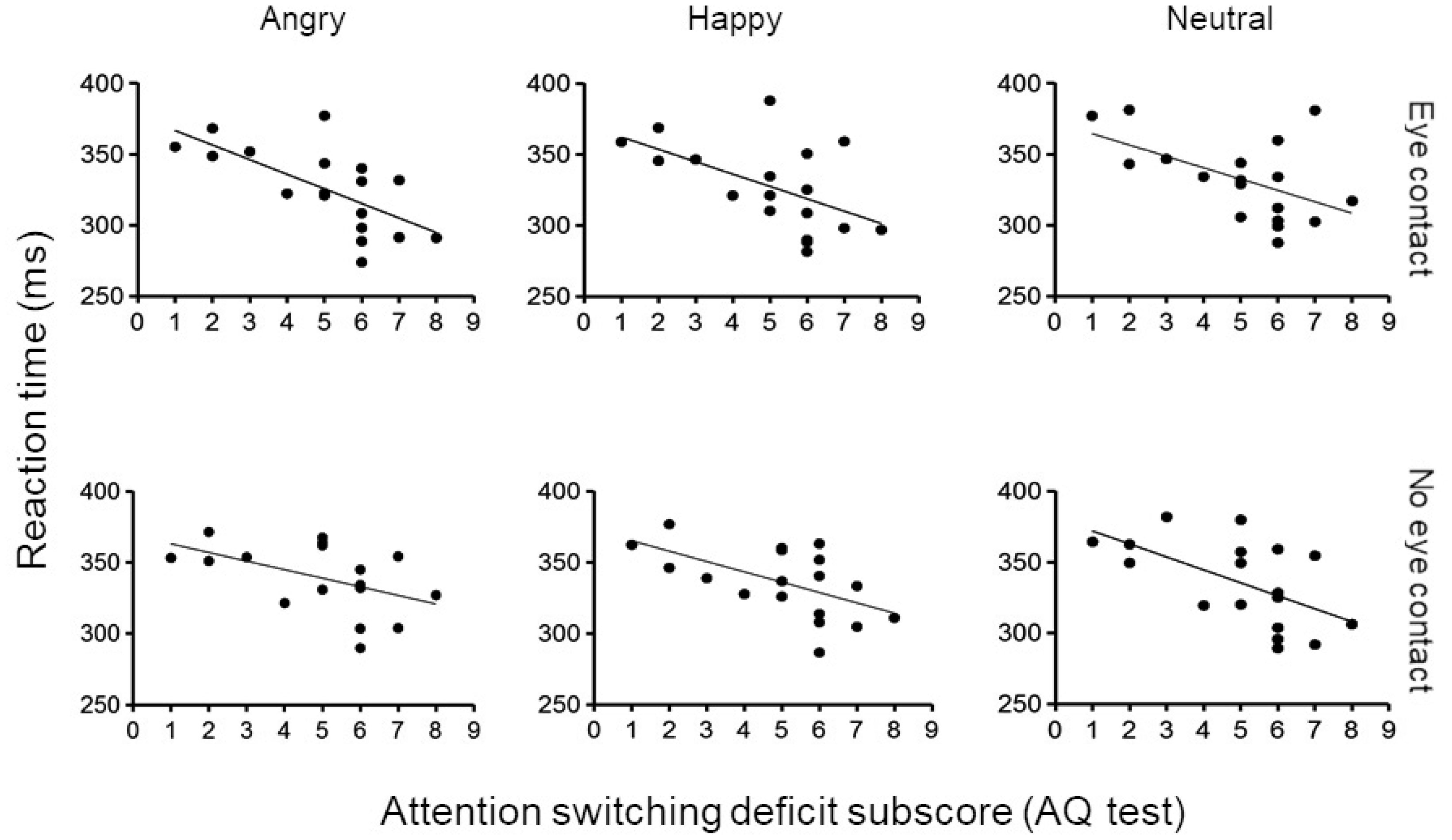Individuals with autism spectrum disorder (ASD) show impairments in processing social cues such as facial expressions and gaze direction. Several researchers have proposed that autistic traits form a continuum that may be distributed within the general, typically developed, population. Accordingly, several studies have indicated that typically developed individuals with high levels of self-reported autistic traits have autistic-like performance in a variety of paradigms. Here, we designed a gaze-cueing task to examine whether gaze-triggered orienting is related to the extent of typically developed (TD) individuals' autistic traits (determined by their AQ test scores) and whether it is modulated by previous eye contact and different facial expressions. At each trial, TD subjects observed faces with or without eye contact. This facial stimulus then gazed toward the left or right side. Finally, a target appeared on the left or right side of the display and reaction time (RT) to the target was measured. RTs were modulated by congruency between gazing directions and target locations, and by prior eye contact in the congruent trials. In addition, individuals with higher AQ scores were slower at detecting the target when the cue was a happy face. Furthermore, faster RTs in congruent trials were associated with one specific autistic trait (attention switching deficits). Together, these results indicate that autistic traits may influence performance in a gaze cueing task.
1.
Introduction
Active living denotes human activities connected to logistics and economic changes in the local geography with respect to the well-being of humans [1,2,3,4,5]. Logistics in today's society has broad definitions. Previously, the term merely signified the transport of goods, materials, and products into the circulation of the supply chain between the producers and consumers [6,7,8]. Nowadays, the term also includes the transport of physical objects in the real world and the exchange of digital information in the virtual world. The modern perspective encompasses physical and virtual logistics. However, the success of logistics continues to be defined based on two key areas: expenditure of time and economic benefits [9,10].
Typically, the term economics implies a non-physical object and relies upon political construction and public policy formation as well as local government strategy [11,12,13,14,15]. Economics is a study of how money is made, how goods are produced and distributed, and how services are provided [16,17]. Thus, it could be directly linked to logistics as an essential skillset. Therefore, producers and consumers of goods and services need to have practical knowledge on how to transfer money and capital resources engaged in logistics and economics [18,19,20,21].
Logistics knowledge is a multidisciplinary research involving computer science, business, economics, healthcare, physics, mathematics, production engineering, and electrical engineering [22,23,24,25,26]. In addition, food science and product technology are involved. Decision making is one of the key skillsets in logistics as well as active living. Researchers have illustrated that a good decision-making on the improvement of local policies, programs, and well-connected road networks support regional logistics and local food products headed to develop the country's economics [27,28,29]. An example of a successful local food product is the Yorkshire pudding that developed the country's economics.
Yorkshire pudding is a traditional local food that has been considered as a local product with promising logistics and economics for more than a century. Thus, to date, it is a classic example of a successful local food product. The invention of Yorkshire pudding may involve the growth of logistics and economics across the globe [30,31,32]. Moreover, rethinking and redesigning the product as a snack or a premium snack by adding a variety of nutritious local ingredients to target different age groups [33,34,35] might be a new way to promote local food products with health benefits. Therefore, popularizing the modern Yorkshire pudding might help in maintaining an active living and lifestyle.
The present study proposes a novel method to obtain information on the innovation of local food products to improve the health benefits, thereby demonstrating that active living is attached to economics and logistics as well as food products. Figure 1 demonstrates a unique tiger bean (UTB) that was reviewed as a local asset and a distinctive local ingredient in Northern Thailand.
2.
Materials and methods
In this work, a survey was conducted for data collection. The data were documented through a questionnaire survey because it is a quick and efficient way to obtain a large amount of data from a study population [36,37]. The survey was deployed in study areas such as schools, government establishments, households, and local businesses. The respondents in the study areas were interviewed through a questionnaire-based survey. The results were recorded manually in paper documents and were later summarized by the interviewees to correct any mistakes in the present study.
2.1. Data collection
The data were collected in Banmaesurin, Khunyuam dale, Mae Hong Son province, Thailand, from August 21 to 23, 2019. The empirical research design was based on the hypothesis that the creation of food products using a unique local ingredient improved the logistics and economics that enhanced active living [29,30]. Two observers (TC, SO) travelled to Banmaesurin for 3 days and collected data pertaining to empirical evidence according to the references [38,39].
2.2. Data collection data classification and critical evaluation strategies
Empirical evidence is factual information that represents the factors of active living in Banmaesurin, including i) rural development, ii) healthy living, iii) life expectancy, iv) food products, v) transport geography, vi) logistics standards, and vii) cost of living. These seven factors were evaluated collectively with open-ended questions (Table 1). The representative population in Khunyuam dale comprised small and medium enterprise (SME) business owners, Khunyuam's school heads, teachers, counselors, and randomly selected residents. The open-ended questions were delivered verbally to the representative group. The critical evaluation was completed using previously described analytical techniques [38,41].
The mathematic model of a simple static stage of active living can be quantified using a linear equation as follows:
where, x and y indicate logistic and economic efforts, respectively, A is transport geography combined with food products, B is rural development along with the cost of living supported by logistics standards, and C is life expectancy together with healthy living. A positive slope signifies effective human activities that affect the growth of logistics and economics, whereas a negative slope denotes the shrinking state.
2.3. Food products
The raw material is UTB produced in Khunyuam dale. The UTB (Arachis hypogaea L.) can be harvested only in Mae Hong Son, Northern Thailand. The local folks named it as "tiger bean" since its appearance resembled a tiger pattern (Figure 1). However, UTB is a member of the monkey nut family or peanut. Table 2 reveals that UTB has lower saturated fat content than a regular peanut [42,43].
The food technology utilized to produce UTB products include i) a traditional cooking technique to roast UTB using a wood-fired oven with slow heating, ii) a blender to mix UTB with organic vegetable oils, iii) modern electric oven to bake UTB (after blending), iv) food hygiene and food safety in production processes, v) food packaging to create UTB products. Finally, three UTB products, including roasted tiger bean, butter tiger bean, and crispy round thin tiger bean cracker, were produced for sale in the commercial markets. These commercial products had a special label that distinctively characterized healthy foods with low-fat attributes.
2.4. Transport geography
The geographical location of Khunyuam dale was assessed, and the transport survey was conducted through walking and driving trips as well as by distributing food products in logistic networks. Figure 2 depicts the geography of Khunyuam dale.
2.5. Local economics
The economic aspects of Khunyuam dale were analyzed in terms of the household economy. The living expenditures of a single family in Banmaesurin, Khunyuam dale, were determined. Table 3 presents the everyday living expenses of a single family.
3.
Results
Based on the data analysis of the invented healthy food products in Banmaesurin, Khunyuam dale, the active living characteristics were classified using open-ended questions, food products, local economics, and transport geography.
3.1. Data visualization and interpretation
The qualitative data were observed and interpreted from a focus group of selective respondents in Banmaesurin, Khunyuam dale. The empirical evidence is displayed in Table 4.
3.2. Graphical representation of active living
Active living factors were analyzed using the empirical evidence explained in Section 2. As a result, active living was defined as follows: "human activities connected to logistic and economic movements in the local geography for human well-being." Figure 3 demonstrates an active living visual aid generated by the computer using simulated data (Table 5). The data were derived using Equation (1) to provide an overview of effective human activities.
3.3. Logistics
Logistic data were collected by interview and survey using open-ended questions in Banmaesurin, Khunyuam dale. Table 6 summarizes the distribution mode of local food products across the country.
Empirical observation revealed that the logistic standard in Khunyuam dale involved planning, functioning, and managing the movement of goods, services, passengers, and products. In addition, local transport through road networks was reviewed. The change in local transport to support the distribution of healthy food products was inspected. Figure 4 illustrates the pathway analysis of logistic information in Khunyuam dale.
3.4. Economics
Empirical evidence showed that the local government policy on electricity played a key role in regional development (Table 4) based on the program and administration of the household economy. When electricity was first introduced in Khunyuam dale, all residents shared the responsibility (e.g., monthly bills, electrical appliances, and domestic wiring system) with the local authority. The water supply requirements were met by natural resources (Figure 2). Khunyuam dale is a rich landscape of agricultural products as well as natural resources. The UTB was determined to be a local asset. To support household economy (Table 3), local food products were produced using distinctive ingredients, which generated income for the families. Hence, the results of the current study confirm that local living standards and economics were improved logistically by modernizing the community food products as the local SMEs.
3.5. Healthy food products
The UTB was chosen as a key ingredient for manufacturing local healthy food products. After review, UTB was found to contain lower saturated fatty acids than other peanuts (Table 2). Subsequently, three food products were successfully produced, as shown in Figure 5. One local food product, the roasted tiger bean, has been launched and is being sold till date, whilst the other products are in the process of entering the markets.
3.6. Demographics
According to the empirical data, the major population in Khunyuam dale comprises the elderly and those in mid and late adulthood. Many families struggled to maintain their household economies, and countless residents relocated to Chiang Mai and other industrialized cities. Numerous youths moved to educational cities for acquiring re-skills and up-skills to take up employment. These movements were not profitable for Khunyuam dale. In this context, the invented local food products have given opportunities to the people and have gained popularity in Khunyuam dale.
4.
Discussion
This study has shown that the invention of local food products has a significant impact on the economics and logistics of rural development in addition to human activities on active living factors with effective outcomes, which can improve the local region and maintain the population. This research has provided empirical evidence as further potential effects could effectuate results from active living factors, thereby guiding the development of a shrinking county by utilizing the natural resources that can significantly support the local household economy.
This study has illustrated that economics is a non-physical objective that depends on the local government's policy and its strategy in addition to the study on the production and distribution of foods, goods, and services in the local supply chain [11,21]. The present study investigated seven active living factors (Table 1) as a cause of healthy living. We hypothesized that local food products produced using a distinctive local ingredient would lead to economic sustainability (Figure 3) [46]. Figure 3 demonstrates that economics and logistics begin with transport geography exploration and food product technology, which resolve the cost of living with respect to the rural development. These factors are supported by logistics (planning transport structure and network connection) (Figure 4). Hence, healthy living and life expectancy can interchange the position while enhancing the growth of logistics and economics [47].
Figure 4 shows that the logistics in Khunyuam dale were planned as a circular route. This analysis preview shows that there are many outbound courses that can reach the supply chains of food products joining major transport connections such as, airports, lorry loading terminals, and multi-option transports (Table 5) in Chiang Mai, Mae Hong Son, Pai city, Tak, and Naypyitaw, the capital city of Myanmar. Moreover, the correlations displayed in Figures 3 and 4 prove that economic progression is in line with logistics development [48]. Table 4 summarizes the data interpreted and visualized through empirical evidence obtained from a selective group of respondents in Khunyuam dale. Importantly, in Table 4, the fourth factor of active living was classified into the economics category, and the residents were expected to have a good income as well as a life-long learning environment to develop new skills for employment.
The local healthy food products mainly include roasted tiger beans, butter tiger beans, and crispy round thin tiger bean crackers, which were developed successfully as shown in this study. Figure 5 reveals the exploration of transport geography upon the selection of a distinctive local ingredient (local asset) with low-fat attributes (Table 2) used for accounting the food products. Furthermore, local economics demonstrated a sign of advanced development as a result of these food products, while negligence of human tasks in an active living led to decreased demographics, as shown by a shrinking graph in Figure 3 [49]. Currently, most of the residents in Khunyuam dale are midlife, late adulthood, and elderly. Thus, future demographics can be diversified when local food products are launched effectively. As seen in Figure 3, the cost of living (Table 3) and rural development are driven by active living factors 1 and 5 [50,51], and supported by factor 6, i.e., the logistics standard (Table 6 and Figure 4). The current finding was further confirmed by the example of an English side dish. The popular Yorkshire pudding was invented in Northern England, and the success of the local food product could be estimated using our chart of active living, as depicted in Figure 3 [30,31,32,33,34,35]. Thus, inventing local foods obviously benefits local economics.
Interestingly, physical inactivity is a universal pandemic and causes economic collapse in the rural setting. It is caused by environmental barriers, inadequate programs, and poor policies [1,2,17,22,35]. A study on rural active living assessment to investigate the environmental barriers has reported that most of the road networks in the rural areas were directed at the promotion of active living [1,2]. The results are in line with our findings and confirm that programs and policies for creating unique local healthy food products and building major road networks promote active living and expand logistics and economics (Figure 3). Another study has found that foods with local and regional identities facilitate regional development and tourism [30,32]. These studies have not established the relationship among local foods, active living, and logistics and economics, an aspect that has been examined in our present investigation. To the best of our knowledge, empirical evidence is a scientifically based research methodology that refers to objective evidence and appears the same regardless of the observer. Our research methodology employed empirical evidence and included measures and data collected through direct observation in the form of a survey. These were meant to test our hypothesis through actual evidence and accurate outcomes when compared to previous studies that used empirical analysis [8,10]. In contrast, empirical analysis is an evidence-based approach that examines and interprets the information by relying on real-world data, metrics, and results rather than hypotheses and theories.
Our investigation is different from previous studies that included different categories of agricultural economics and innovation in food products [52,53,54,55,56,57,58]. As an invention of local food products, economics and logistics spread widely throughout the country. Our results are in agreements with former studies [59,60,61,62]. Besides, our findings assert the importance of using unique local ingredients to produce healthy foods. This creates an understanding that food sectors play a key role in maintaining the population, this is in line with previous findings [60,63]. However, decision making in management was behind the development of local food products. It requires improvements aimed at promoting social, environmental, and economic sustainability. These improvements are a part of sustainable innovation [50,64]. Thus, sustainable innovation could serve as a potential future direction for research in the field of agriculture and food.
Nevertheless, the present study has some limitations. First, Khunyuam dale's population is relatively small, and empirical evidence was obtained from a focus group of selective respondents. However, previous studies have asserted the assumption tested on the selective group [65,66,67,68,69,70]. Second, the hypothesis of active living could only obtain the demographics with respect to late adulthood, midlife, and elderly since the youth population was unstable. Third, the sales figures were not included in the present study. Interestingly, the only local food product launched was a roasted tiger bean, whilst the other two food products are in the process of entering the market. Hence, future studies must use a diverse population with a large number of selective groups as well as include sales figures of various food products.
5.
Conclusions
This work explored the invention of local food growth logistics and economics in Banmaesurin, Khunyuam dale, Mae Hong Son, Thailand. The hypothesis of active living was based on seven factors, namely rural development, healthy living, life expectancy, food products, transport geography, logistics standard, and cost of living. Empirical evidence was obtained through a group of selective respondents comprising SME business owners, local councilors, heads of local schools, and teachers through direct discussions. The results showed that active living created by effective human tasks powered the growth of economics and logistics in regional development. To summarize, producing healthy food products using unique local ingredients profits the community and maintains the livelihood of the citizens. Nevertheless, additional studies focusing on the virtual logistics business model of food production management are required to corroborate the present findings.
Acknowledgments
Authors sincerely express special thank you to the Chiang Mai University, and the College of Maritime Studies and Management, Chiang Mai University (Maritime CMU) for their generosity in providing supports, resources and funding to complete this research. We appreciate and acknowledge all hard works and helps received from staffs of Maritime CMU. This work dedicates to the local community improvement. We also thank Mrs Phuangphaka Thunchawon and Mr Bunsue Thunchawon for assisting this work.
Conflict of interest
The authors declare no conflict of interest.
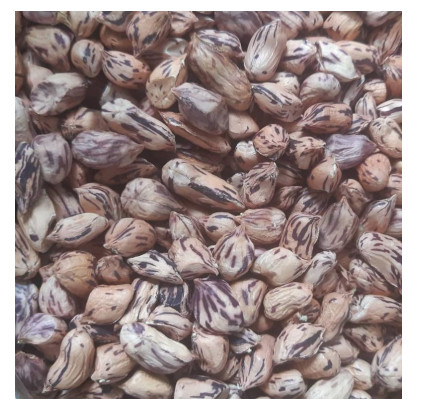









 DownLoad:
DownLoad:
